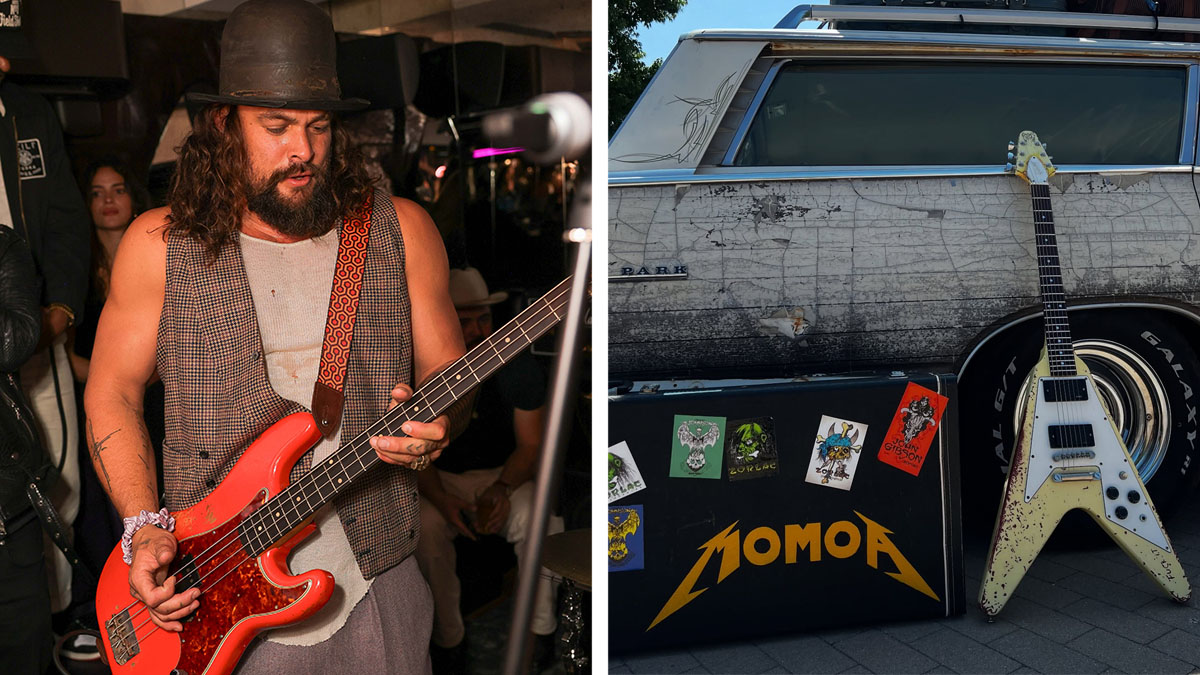“Recreating this piece of metal history wasn’t just a challenge, it was a privilege”: Jason Momoa orders super-gnarly replica of James Hetfield’s iconic Elektra OGV – and this Polish luthier recreated every last detail
Momoa's downstroke game better be on point because Krupi Guitars went to town on recreating the guitar that made Metallica

Jason Momoa has commissioned an exacting replica of James Hetfield’s iconic Elektra Flying V copy from Polish custom electric guitar company Krupi Guitars, and it looks and sounds incredible.
This is a copy of one of the most-famous copycat electrics of all time, the so-called OGV – the white Elektra Flying Wedge that Hetfield used on Metallica’s seminal 1983 debut album, Kill ‘Em All, and thrashed into submission over the subsequent years as the Bay Area quartets charted their unstoppable rise to superstardom.
Krupi has replicated the OGV in exacting detail, from the finish wear to the hardware (aftermarket Sperzel locking tuners FTW), to the middle finger graphic on the back – Krupi even recreated the effect of original OGV’s infamous headstock break.
That break, lest we forget, was a hinge-moment in Metallica (and metal guitar) history because the OGV’s temporary absence while a luthier in Austin, TX, was repairing it gave Hetfield the opportunity to check out the Gibson Explorer, and he liked what he heard.
Krupi says it was an honor to work on this replica.
“Here’s a faithful replica of James Hetfield’s legendary Electra OGV – the very guitar that roared on Kill ‘Em All and helped forge the sound of Metallica’s early days,” it writes on Instagram. “Some time ago Jason Momoa – [whom] I truly admire, a huge Metallica fan – reached out to ask if I could build one just like it. I did. And I poured everything into it.
“Recreating this piece of metal history wasn’t just a challenge – it was a privilege. It meant a lot to us, both as a builders and a fans. Enjoy it, Jason.”
All the latest guitar news, interviews, lessons, reviews, deals and more, direct to your inbox!
This is not just about the guitar, though. Just look at that guitar case. You’ve got Momoa’s name emblazoned on it in the Metallica typeface – in a shade of yellow-orange that makes us think of the Jump in the Fire 12” – and a whole bunch of Zorlac stickers featuring the work of artist Brian Schroeder, better known as Pushead, who has provided some iconic designs for Metallica’s merch.
Pushead’s Damage Inc. and Harvester of Sorrow T-shirt designs are all-timers. Anyway, those stickers really tie the whole thing together.
And somehow, the OGV, battered, bruised, repaired, is still in Hetfield’s regular rotation. Not bad for a cheap copy. It looked the part. It sounded the part.
In his 2023 coffee table book Messengers: The Guitars of James Hetfield, the Metallica frontman recalled how drummer Lars Ulrich reacted when he first saw it.
“What I think about most is how happy I was when Lars came over [to see it], because it felt like the beginning of all the ‘coolness’ that we were trying to achieve,” said Hetfield. “It felt like we had arrived… [like] we were going to make it… I did not care that it was a copy of a Gibson. It played great, it sounded great, and it had the look that I wanted.”
There was no need to sweat the details. Hetfield didn’t. For a time, he was famously unaware that it actually was a copy.
“I thought it was a Gibson Flying V, just like the one Michael Schenker used,” said Hetfield. “That’s all I cared about. It was white, it was a V-shape, it had a Gibson plate on it, and it was cheap.”
A post shared by 𝕶 𝕽 𝖀 𝕻 𝕴 (@krupi.guitars)
A photo posted by on
Japanese copies of classic US electric guitar designs were getting better as the 1980s dawned. Some collectors argue that they sound better than the Gibson or Fender counterparts of the ‘70s, the imitators challenging the US companies to up their game.
But Hetfield’s Flying Wedge was not quite as exacting with the spec as some copycat imports. Take the neck joint for a start. Not that a young Hetfield cared about these things.
“Now I know why [it was cheap], because it was made in Japan,” he said. “For me, it didn't matter. Later on, I think when we were in New York the first time, somebody said, ‘Err, that’s not a Gibson! It’s got a bolt-on neck!’ I didn’t know, and I didn’t care.”

And it didn’t matter. It sounded ferocious, especially when going through the Metallica frontman’s legendary Marshall amp, which was stolen after the recording of Kill ‘Em All and lost to history. Hetfield described the OGV as “like a shield”, giving him the confidence to front a band that would spearhead thrash metal’s ascendancy.
“I’m not being overly dramatic in saying that if there was a guitar that changed the course of my history, it was the OGV,” said Hetfield. “It's one of the fastest guitars I have to this day, with very, very good mids. It's very clear but crunchy, too.”
Jonathan Horsley has been writing about guitars since 2005, playing them since 1990, and regularly contributes to publications including Guitar World, MusicRadar and Total Guitar. He uses Jazz III nylon picks, 10s during the week, 9s at the weekend, and shamefully still struggles with rhythm figure one of Van Halen’s Panama.
You must confirm your public display name before commenting
Please logout and then login again, you will then be prompted to enter your display name.



